

SDLC - Incremental Model - Quality Testing. Incremental Model The incremental model is an intuitive approach to the waterfall model.
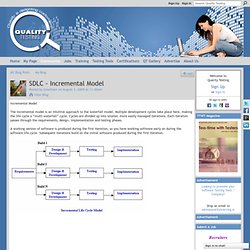
Multiple development cycles take place here, making the life cycle a “multi-waterfall” cycle. Cycles are divided up into smaller, more easily managed iterations. Scrum – Beginners Guide To Scrum. Scrum is an agile way to manage a project, usually software development.
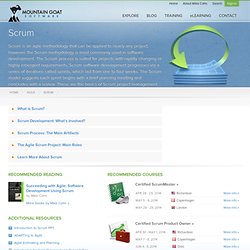
Agile software development with Scrum is often perceived as a methodology; but rather than viewing Scrum as methodology, think of it as a framework for managing a process. In the agile Scrum world, instead of providing complete, detailed descriptions of how everything is to be done on a project, much of it is left up to the Scrum software development team. This is because the team will know best how to solve the problem they are presented. This is why in Scrum development, for example, a sprint planning meeting is described in terms of the desired outcome (a commitment to a set of features to be developed in the next sprint) instead of a set of Entry criteria, Task definitions, Validation criteria, Exit criteria (ETVX) and so on, as would be provided in most methodologies.
What is SCRUM? Contents Introduction.
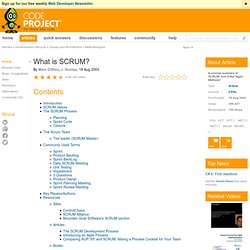
Scrum Methodology & Agile Scrum Methodologies. Project Lifecycle Models: How the differ and when to use them. Business eSolutions provides System Development Project Management services, Problem Project Diagnostic and Recovery services and Project Management Training and Facilitation courses covering strategy, project management, project estimating, business requirements, risk management and quality assurance.

We can help you define a lifecycle methodology customized to your organizational strengths and development risks. Our mission is to help our clients produce quality systems on time and on budget. Www.acasa.upenn.edu/JGsystems.pdf. Agile Methodology - Agile Methodologies for Software Development. The various agile methodologies share much of the same philosophy, as well as many of the same characteristics and practices.

But from an implementation standpoint, each has its own recipe of practices, terminology, and tactics. Here we have summarized a few of the main methodology contenders: Scrum Scrum is a lightweight agile project management framework with broad applicability for managing and controlling iterative and incremental projects of all types.
Ken Schwaber, Mike Beedle, Jeff Sutherland and others have contributed significantly to the evolution of Scrum over the last decade. In Scrum, the "Product Owner" works closely with the team to identify and prioritize system functionality in form of a "Product Backlog". Scrum has been proven to scale to multiple teams across very large organizations with 800+ people. Lean and Kanban Software Development Lean Software Development is an iterative agile methodology originally developed by Mary and Tom Poppendieck. Extreme Programming (XP) WATERFALL vs. AGILE METHODOLOGY « Agile Introduction For Dummies.
There is no IT meeting that does not talk and debate endlessly about Waterfall vs.
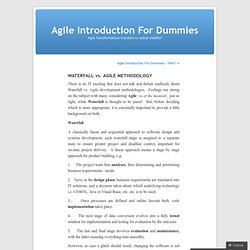
Agile development methodologies. Feelings run strong on the subject with many considering Agile ‘so of the moment’, just so right, while Waterfall is thought to be passé! Csrc.nist.gov/publications/nistbul/april2009_system-development-life-cycle.pdf. Life cycles: methodologies compared. History The "waterfall model", documented in 1970 by Royce was the first publicly documented life cycle model.

What Lifecycle? Selecting the Right Model for Your Project. A cynical senior manager said, “It feels as if I’m stuck between the traditionalists and the agilistas.
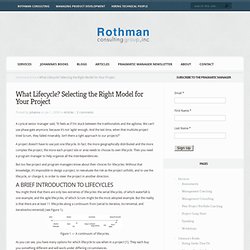
We can’t use phase-gate anymore, because it’s not ‘agile’ enough. And the last time, when that multisite project tried Scrum, they failed miserably. Isn’t there a right approach to our projects?” Wise.vub.ac.be/sites/default/files/publications/integratingV.pdf. Agile Test Methodology Vs V Model. Software Process Models. Many process models I came across so far have their background in a certain engineering setup which I call "the happy engineering world".
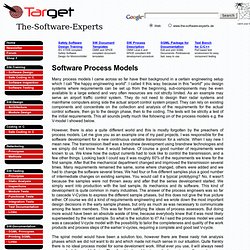
I called it this way, because in this "world" you design systems where requirements can be set up from the beginning, sub-components may be even available to a large extend and very often resources are not strictly limited. As an example may serve an airport traffic control system. Heuristics, rules of thumb, and the 80/20 proposition. Control Chaos - Control Chaos. What is Extreme Programming (XP)? - Definition from WhatIs.com. Extreme Programming (XP) is a pragmatic approach to program development that emphasizes business results first and takes an incremental, get-something-started approach to building the product, using continual testing and revision.
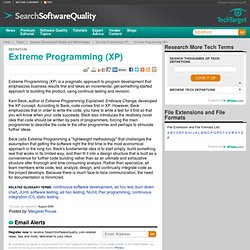
Kent Beck, author of Extreme Programming Explained: Embrace Change, developed the XP concept. According to Beck, code comes first in XP. However, Beck emphasizes that in order to write the code, you have to write a test for it first so that you will know when your code succeeds. Beck also introduces the relatively novel idea that code should be written by pairs of programmers, forcing the main programmer to describe the code to the other programmer and perhaps to stimulate further ideas.
Beck calls Extreme Programming a "lightweight methodology" that challenges the assumption that getting the software right the first time is the most economical approach in the long run. This was last updated in August 2008 Email Alerts More News and Tutorials. The Death of the V-Model. The V-Model of software development is widely in use today, especially in the defence industry. It’s a pity then, that it is fundamentally flawed, and that it is responsible for misleading project managers into thinking that the project they are about to undertake is well understood.
The reality is that the more the V-Model is used as a tool to manage the software development process, the more likely that project is to fail. The following diagram is a typical representation of the V-Model. The development life cycle follows a fixed path from Requirements Analysis to Operational Testing and subsequent delivery to the customer.
Testing tasks are generated from knowledge gained from development tasks, for instance the High Level Design will generate the Integration Tests. This model does have a number of good points, such as: It defines tangible phases of the process, and proposes a logical sequence in which these phases should be approached.